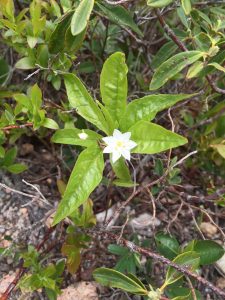To ID Acadia’s climate-vulnerable plants, McDonough MacKenzie hit the hiking trails
National Park Service managers wanted to identify plants that might be vulnerable in Acadia National Park, but they didn’t have decades of flowering and leaf-out observations for researchers to analyze.
So Caitlin McDonough MacKenzie and colleagues took an innovative approach. In four years, they collectively hiked three mountains — Cadillac, Pemetic and Sargent — in Acadia 180 times, about 15 times per mountain per year, to collect decades’ worth of data.
McDonough MacKenzie hit the trails 125 times.

McDonough MacKenzie — who completed the research as a doctoral student at Boston University and is now the David H. Smith Conservation Research Fellow at the University of Maine Climate Change Institute — recorded more than 20,000 observations of flowering and leaf out for 30 species.
With her field assistants, she determined that most plants in Acadia National Park track spring temperatures, and bloom and leaf out earlier in warmer spots and warmer years.
Flowering is advancing two to six days for each degree Celsius (1.8 degrees Fahrenheit) of warmer temperatures, and leaf out is advancing two to three-and-a-half days per degree Celsius, says McDonough MacKenzie.
Many of Acadia’s plants, including lowbush blueberry, bunchberry and starflower, grow at all elevations, from the trailheads to the summits.
“It’s not as simple as the bottom of the mountain leafs out, and then spring evenly spreads uphill,” she says.
“We found that sometimes high-elevation sites have warmer temperatures or sometimes the southern aspect is cooler than the northern aspect. But, wherever the warmest sites are in a given year, that’s where we are most likely to see the first leaf out and flowering.”
The timing of flowering and leaf out is tied to ecosystem services and interactions — like herbivory (feeding on plants) and pollination — and it’s important to the timing of management actions, including invasive species control.
McDonough MacKenzie says data from repeat hikes can help managers refine climate change vulnerability assessments.
Other studies have shown a plant’s ability to track spring temperatures and that advance flowering in warmer years is correlated with population persistence, and plants that do not track spring temperatures are more likely to decline in abundance.
“It’s not surprising to see plants shifting their leaf out and flowering with spring temperatures. We see this over and over again in other places and other species,” McDonough MacKenzie says.
“But, it’s great to be able to capture this trend relatively quickly, without the advantage of a (Henry David) Thoreau or an Aldo Leopold notebook providing decades of data. Park managers need information on the phenology in their parks, but most places don’t have a set of Thoreau records just hanging out in the archives, waiting for a climate change researcher to come along.”

Most of the species that the team studied tracked changes in temperature, but starflower did not, which suggests it may be vulnerable to future changes in climate in Acadia, says McDonough MacKenzie.
Moreover, species’ flowering and leaf-out shifts in Acadia National Park weren’t necessarily the same as they were in Thoreau’s home of Concord, Massachusetts. Some species tracked temperatures better in one place than the other.
Abraham Miller-Rushing, science coordinator for Acadia National Park and a co-author of the study, says this approach to assessing phenology — the timing of seasonal biological events — can help conservation biologists and resource managers protect natural resources in a changing environment.
”Phenology is critical to ecosystem services, interactions between species, like plants and pollinators, and to the timing of management actions,” he says. “Most protected areas don’t have long-term data, but this trails-as-transects approach could generate the necessary data in just a few years.”
The study was designed to follow popular hiking trails so citizen science volunteers can continue the research, observing future flowering and leaf out.
The researchers found that monitoring the North Ridge Trail and South Ridge Trail up and down Cadillac Mountain was sufficient to capture trends in phenology.
Richard Primack, professor at Boston University and a study co-author, says, “This research is innovative for its use of trails and environmental gradients to quickly collect data that scientists and managers need — data that scientists or volunteers could collect.”
The researchers say this type of intensive monitoring — hiking the same trails over and over again — can be replicated in other protected areas with environmental gradients to quickly build robust data sets for land managers.
The study, “Trails-as-transects: phenology monitoring across heterogenous microclimates in Acadia National Park, Maine,” was published in the journal Ecosphere.
In addition to the study’s scientific value, McDonough MacKenzie says she appreciated the opportunity to spend so much time on the mountains.
“The solitude of hiking early in the morning, and standing alone on the summit in one of the most popular national parks was really special,” she says.
“One of the first times I hiked Cadillac, I passed a couple who were eating lunch near the summit and they asked if I had lost something because I was looking down at the plants instead of out at the amazing view. Sometimes when I’m bored or waiting for a doctor’s appointment, I’ll just hike Sargent in my head, and move through the trail by memory.”

